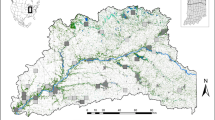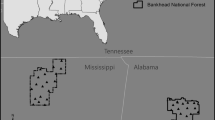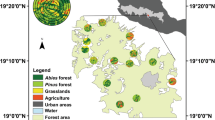Abstract
Quantifying spatial genetic structure is key to inform forest management and restoration strategies. Reliable evaluations of genetic structure require sound sampling schemes because inappropriate sampling may over- and under-estimate spatial patterns of genetic structure. Sampling bias has been investigated through computer simulations mostly for animal species with continuous distributions. For tree species that have different life history traits, results from such studies may not apply. Here, I used spatially explicit landscape genetic simulations to assess the effects of spatial sampling scheme (random, systematic, and cluster), sampling intensity (35, 50, 65, and 80%), and the number of microsatellite loci (8, 14, and 20) on inferences of genetic structure under isolation by distance (IBD) in two forest tree species with varying dispersal distances and patchy distributions. Results showed that random sampling with 20 loci was the best performing sampling scheme, irrespective of sampling intensity and the strength of IBD. In contrast, the cluster and systematic sampling were sensitive to sample size. For the three sampling schemes, the number of loci had a large effect because with 8 loci there was an increasing chance of underestimating IBD. Increasing the number of samples over the number of loci, did not improve the performance of sampling schemes. Hence, researchers should put more effort on increasing the number of loci over increasing sample size. Results also showed that sampling error rates varied between species, and sampling bias appeared stronger for the species with a more aggregated spatial distribution.




Similar content being viewed by others
References
Abeysinghe PD, Triest L, Greef BD et al (2000) Genetic and geographic variation of the mangrove tree Bruguiera in Sri Lanka. Aquat Bot 67:131–141. doi:10.1016/S0304-3770(99)00096-0
Ahmed S, Compton SG, Butlin RK, Gilmartin PM (2009) Wind-borne insects mediate directional pollen transfer between desert fig trees 160 kilometers apart. Proc Natl Acad Sci USA 106:20342–20347. doi:10.1073/pnas.0902213106
Alberto FJ, Aitken SN, Alía R et al (2013) Potential for evolutionary responses to climate change—evidence from tree populations. Glob Change Biol 19:1645–1661. doi:10.1111/gcb.12181
Anderson CD, Epperson BK, Fortin MJ et al (2010) Considering spatial and temporal scale in landscape-genetic studies of gene flow. Mol Ecol 19:3565–3575. doi:10.1111/j.1365-294X.2010.04757.x
Arroyo JM, Rigueiro C, Rodríguez R et al (2010) Isolation and characterization of 20 microsatellite loci for laurel species (Laurus, Lauraceae). Am J Bot 97:e26–e30. doi:10.3732/ajb.1000069
Baird NA, Etter PD, Atwood TS et al (2008) Rapid SNP discovery and genetic mapping using sequenced RAD markers. PLoS One 3:e3376. doi:10.1371/journal.pone.0003376
Bankenhol N, Fortin MJ (2016) Basics of study design: sampling landscape heterogeneity and genetic variation for landscape genetic studies. In: Bankenhol N, Cushman S, Storfer A, Waits L (eds) Landscape genetics: concepts, methods, applications. Wiley, Chichester, pp 58–76. doi:10.1002/9781118525258.ch05
Bonfil-Sanders C, Cajero-Lázaro I, Evans RY (2008) Germinación de semillas de seis especies de Bursera del centro de México. Agrociencia 42:827–834
Bowcock AM, Ruiz-Linares A, Tomfohrde J, Minch E, Kidd JR, Cavalli-Sforza LL (1994) High resolution of human evolutionary trees with polymorphic microsatellites. Nature 368:455–457
Broadhurst LM, Lowe A, Coates DJ et al (2008) Seed supply for broadscale restoration: maximizing evolutionary potential. Evol Appl 1:587–597. doi:10.1111/j.1752-4571.2008.00045.x
Caetano S, Silveira P, Spichiger R, Naciri-Graven Y (2005) Identification of microsatellite markers in a neotropical seasonally dry forest tree, Astronium urundeuva (Anacardiaceae). Mol Ecol Notes 5:21–23. doi:10.1111/j.1471-8286.2004.00814.x
Calderón de Rzedowski G, Germán MT (1993) Meliaceae. Flora del Bajío y de Regiones Adyacentes 11:1–5
Cantarello E, Newton AC, Hill RA et al (2011) Simulating the potential for ecological restoration of dryland forests in Mexico under different disturbance regimes. Ecol Model 222:1112–1128. doi:10.1016/j.ecolmodel.2010.12.019
Carrillo-Ángeles IG, Mandujano MC (2011) Patrones de distribución espacial en plantas clonales. Bol Soc Bot Mex 89:1–18
de Campos Telles MP, Dobrovolski R, da Silva e Souza K et al (2014) Disentangling landscape effects on population genetic structure of a neotropical savanna tree. Nat Conserv 12:65–70. doi:10.4322/natcon.2014.012
Dubreuil M, Riba M, González-Martínez SC et al (2010) Genetic effects of chronic habitat fragmentation revisited: strong genetic structure in a temperate tree, Taxus baccata (Taxaceae), with great dispersal capability. Am J Bot 97:303–310. doi:10.3732/ajb.0900148
Elshire RJ, Glaubitz JC, Sun Q et al (2011) A robust, simple genotyping-by-sequencing (GBS) approach for high diversity species. PLoS One 6:e19379. doi:10.1371/journal.pone.0019379
Encino-Ruiz L, Lindig-Cisneros R, Gómez-Romero M (2014) Desempeño de tres especies arbóreas del bosque tropical caducifolio en un ensayo de restauración ecológica. Bot Sci 91:107–114. doi:10.17129/botsci.406
Ennos RA (2001) Inferences about spatial processes in plant populations from the analysis of molecular markers. In: Silvertown J, Antonovics J (eds) Integrating ecology and evolution in a spatial context. Blackwell, Oxford, pp 45–57
Epperson BK (2007) Plant dispersal, neighbourhood size and isolation by distance. Mol Ecol 16:3854–3865. doi:10.1111/j.1365-294X.2007.03434.x
Frankham R (2010) Challenges and opportunities of genetic approaches to biological conservation. Biol Conserv 143:1919–1927. doi:10.1016/j.biocon.2010.05.011
Goslee SC, Urban DL (2007) The ecodist package for dissimilaritybased analysis of ecological data. J Stat Softw 22:1–19
Guillot G, Rousset F (2013) Dismantling the Mantel tests. Methods Ecol Evol 4:336–344. doi:10.1111/2041-210x.12018
Hall LA, Beissinger SR (2014) A practical toolbox for design and analysis of landscape genetics studies. Landsc Ecol 29:1487–1504. doi:10.1007/s10980-014-0082-3
Hampe A, Petit RJ (2005) Conserving biodiversity under climate change: the rear edge matters. Ecol Lett 8:461–467. doi:10.1111/j.1461-0248.2005.00739.x
He J, Chen L, Si Y et al (2009) Population structure and genetic diversity distribution in wild and cultivated populations of the traditional Chinese medicinal plant Magnolia officinalis subsp. biloba (Magnoliaceae). Genetica 135:233–243. doi:10.1007/s10709-008-9272-8
Hernández G, Buonamici A, Walker K et al (2008) Isolation and characterization of microsatellite markers for Cedrela odorata L. (Meliaceae), a high value neotropical tree. Conserv Genet 9:457–459. doi:10.1007/s10592-007-9334-y
Hoban S (2014) An overview of the utility of population simulation software in molecular ecology. Mol Ecol 23:2383–2401. doi:10.1111/mec.12741
Hoban S, Schlarbaum S (2014) Optimal sampling of seeds from plant populations for ex situ conservation of genetic biodiversity, considering realistic population structure. Biol Conserv 177:90–99. doi:10.1016/j.biocon.2014.06.014
Hoban S, Strand A (2015) Ex situ seed collections will benefit from considering spatial sampling design and species’ reproductive biology. Biol Conserv 187:182–191. doi:10.1016/j.biocon.2015.04.023
Hoban S, Gaggiotti O, Bertorelle G (2013) Sample planning optimization tool for conservation and population genetics (SPOTG): a software for choosing the appropriate number of markers and samples. Methods Ecol Evol 4:299–303. doi:10.1111/2041-210x.12025
Jenkins DG, Carey M, Czerniewska J et al (2010) A meta-analysis of isolation by distance: relic or reference standard for landscape genetics? Ecography. doi:10.1111/j.1600-0587.2010.06285.x
Kalisz S, Nason JD, Hanzawa FM, Tonsor SJ (2001) Spatial population genetic structure in Trillium grandiflorum: the roles of dispersal, mating, history, and selection. Evolution 55:1560–1568. doi:10.1111/j.0014-3820.2001.tb00675.x
Keller D, Holderegger R, Van Strien MJ (2013) Spatial scale affects landscape genetic analysis of a wetland grasshopper. Mol Ecol 22:2467–2482. doi:10.1111/mec.12265
Kenfack D, Dick CW (2009) Isolation and characterization of 15 polymorphic microsatellite loci in Tetragastris panamensis (Burseraceae), a widespread Neotropical forest tree. Conserv Genet Resour 1:385–387. doi:10.1007/s12686-009-9089-5
Koen EL, Bowman J, Garroway CJ, Wilson PJ (2013) The Sensitivity of genetic connectivity measures to unsampled and under-sampled sites. PLoS One. doi:10.1371/journal.pone.0056204
Kossinets G (2006) Effects of missing data in social networks. Soc Netw 28(3):247–268
Landguth EL, Balkenhol N (2012) Relative sensitivity of neutral versus adaptive genetic data for assessing population differentiation. Conserv Genet 13:1421–1426. doi:10.1007/s10592-012-0354-x
Landguth EL, Cushman SA (2010) Cdpop: a spatially explicit cost distance population genetics program. Mol Ecol Resour 10:156–161. doi:10.1111/j.1755-0998.2009.02719.x
Landguth EL, Schwartz MK (2014) Evaluating sample allocation and effort in detecting population differentiation for discrete and continuously distributed individuals. Conserv Genet 15:981–992. doi:10.1007/s10592-014-0593-0
Landguth EL, Fedy BC, Oyler-McCance SJ et al (2012) Effects of sample size, number of markers, and allelic richness on the detection of spatial genetic pattern. Mol Ecol Resour 12:276–284. doi:10.1111/j.1755-0998.2011.03077.x
Landguth EL, Bearlin A, Day CC, Dunham J (2016) CDMetaPOP: an individual-based, eco-evolutionary model for spatially-explicit simulation of landscape demogenetics. Methods Ecol Evol. doi:10.1111/2041-210X.12608
Latch EK, Rhodes OE (2006) Evidence for bias in estimates of local genetic structure due to sampling scheme. Anim Conserv 9:308–315. doi:10.1111/j.1469-1795.2006.00037.x
Luximon N, Petit EJ, Broquet T (2014) Performance of individual vs. group sampling for inferring dispersal under isolation-by-distance. Mol Ecol Resour 14:745–752. doi:10.1111/1755-0998.12224
Mantel N (1967) The detection of disease clustering and a generalized regression approach. Cancer Res 27:209–220
McCauley DE (1997) The relative contributions of seed and pollen movement to the local genetic structure of Silene alba. J Hered 88:257–263. doi:10.1093/oxfordjournals.jhered.a023103
Meirmans PG (2012) The trouble with isolation by distance. Mol Ecol 21:2839–2846. doi:10.1111/j.1365-294X.2012.05578.x
Nathan R, Katul GG, Horn HS et al (2002) Mechanisms of long-distance dispersal of seeds by wind. Nature 418:409–413. doi:10.1038/nature00844
Naujokaitis-Lewis IR, Rico Y, Lovell J et al (2013) Implications of incomplete networks on estimation of landscape genetic connectivity. Conserv Genet 14:287–298
Oyler-McCance SJ, Kahn NW, Burnham KP et al (1999) A population genetic comparison of large- and small-bodied sage grouse in Colorado using microsatellite and mitochondrial DNA markers. Mol Ecol 8:1457–1465. doi:10.1046/j.1365-294X.1999.00716.x
Oyler-McCance SJ, Fedy BC, Landguth EL (2013) Sample design effects in landscape genetics. Conserv Genet 14:275–285. doi:10.1007/s10592-012-0415-1
Peterman W, Brocato ER, Semlitsch RD, Eggert LS (2016) Reducing bias in population and landscape genetic inferences: the effects of sampling related individuals and multiple life stages. PeerJ 4:e1813. doi:10.7717/peerj.1813
Petit RJ, Duminil J, Fineschi S et al (2005) Comparative organization of chloroplast, mitochondrial and nuclear diversity in plant populations. Mol Ecol 14:689–701. doi:10.1111/j.1365-294X.2004.02410.x
Prunier JG, Kaufmann B, Fenet S et al (2013) Optimizing the trade-off between spatial and genetic sampling efforts in patchy populations: towards a better assessment of functional connectivity using an individual-based sampling scheme. Mol Ecol 22:5516–5530. doi:10.1111/mec.12499
Rebaudo F, Le Rouzic A, Dupas S et al (2013) SimAdapt: an individual-based genetic model for simulating landscape management impacts on populations. Methods Ecol Evol 4:595–600. doi:10.1111/2041-210X.12041
Rico Y, Lorenzo C, González-Cózatl FX, Espinoza E (2008) Phylogeography and population structure of the endangered Tehuantepec jackrabbit Lepus flavigularis: implications for conservation. Conserv Genet 9:1467–1477
Rzedowski J, Guevara-Féfer F (1992) Burseraceae. Flora del Bajío y de regiones adyacentes 3:46
Rzedowski J, Zamudio S, Calderón G, Paizanni A (2014) El bosque tropical caducifolio en la cuenca lacustre de Pátzcuaro. Michoacán, México
Sánchez-Martínez E, Hérnandez-Oria JG, Hernández-Martínez MM, Maruri-Aguilar B, Torres-Galeana LE, Chávez-Martínez R (2011) Consejo de Ciencia y Tecnología del Estado de Querétaro, Querétaro, México
Sato H, Adenyo C, Harata T et al (2014) Isolation and characterization of microsatellite loci for the large-seeded Tree Protorhus deflexa (Anacardiaceae). Appl Plant Sci 2:1300046. doi:10.3732/apps.1300046
Savolainen O, Lascoux M, Merilä J (2013) Ecological genomics of local adaptation. Nat Rev Genet 14:807–820. doi:10.1038/nrg3522
Schwartz MK, McKelvey KS (2009) Why sampling scheme matters: the effect of sampling scheme on landscape genetic results. Conserv Genet 10:441–452. doi:10.1007/s10592-008-9622-1
Tabachnick BG, Fidell LS (2007) Using multivariate statistics, 5th edn. Allyn and Bacon Inc, Boston
R Development Core Team (2016) R: A language and environment for statistical computing. R Foundation for Statistical Computing, Vienna. ISBN 3-900051-07-0. http://www.R-project.org
Tucker JM, Schwartz MK, Truex RL et al (2014) Sampling affects the detection of genetic subdivision and conservation implications for fisher in the Sierra Nevada. Conserv Genet 15:123–136. doi:10.1007/s10592-013-0525-4
van Strien MJ, Holderegger R, Van Heck HJ (2014) Isolation-by-distance in landscapes: considerations for landscape genetics. Heredity 114:27–37. doi:10.1038/hdy.2014.62
Vekemans X, Hardy OJ (2004) New insights from fine-scale spatial genetic structure analyses in plant populations. Mol Ecol 13:921–935. doi:10.1046/j.1365-294X.2004.02076.x
Wagner HH, Fortin MJ (2016) Basics of spatial data analysis: linking landscape and genetic data for landscape genetic studies. In: Bankenhol N, Cushman S, Storfer A, Waits L (eds) Landscape genetics: concepts, methods, applications. Wiley, Chichester, pp 77–100. doi:10.1002/9781118525258.ch05
Wang Z-F, Lian J-Y, Ye W-H et al (2016) Pollen and seed flow under different predominant winds in wind-pollinated and wind-dispersed species Engelhardia roxburghiana. Tree Genet Genomes 12:19. doi:10.1007/s11295-016-0973-3
Zeller KA, Creech TG, Millette KL et al (2016) Using simulations to evaluate Mantel-based methods for assessing landscape resistance to gene flow. Ecol Evol. doi:10.1002/ece3.2154
Zhao R, Xia H, Lu BR (2009) Fine-scale genetic structure enhances biparental inbreeding by promoting mating events between more related individuals in wild soybean (Glycine soja; Fabaceae) populations. Am J Bot 96:1138–1147. doi:10.3732/ajb.0800173
Acknowledgements
Thanks to Michelle DiLeo for explaining details of running the computer simulations in CDPOP. Also thanks to the organizing committee of the Gene Conservation of Tree Species workshop and to Kevin Potter and Richard Sniezko for the invitation to submit my work to this special issue. Special thanks to Erin Landguth and other anonymous reviewer, which comments improved the quality of this work. The author declare that no conflict of interest exists.
Author information
Authors and Affiliations
Corresponding author
Rights and permissions
About this article
Cite this article
Rico, Y. Using computer simulations to assess sampling effects on spatial genetic structure in forest tree species. New Forests 48, 225–243 (2017). https://doi.org/10.1007/s11056-017-9571-y
Received:
Accepted:
Published:
Issue Date:
DOI: https://doi.org/10.1007/s11056-017-9571-y




